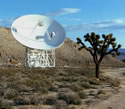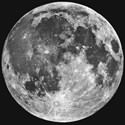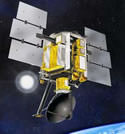
Image credit: NASA
Later this week, NASA scientists will attempt to contact the distant Pioneer 10 spacecraft, which was launched 30 years ago. The team will try to reach the spacecraft by focussing a radio telescope at the Jet Propulsion Laboratory?s Deep Space Network (DSN) in Madrid, Spain. Launched on March 2, 1972, Pioneer 10 is now 11.9 billion kilometres away from the Earth and hasn’t been heard from since April 2001.
NASA scientists will try to contact Pioneer 10 this week to see if the plucky little spacecraft?s signal can still be heard ? 30 years after its launch.
On March 2, 2002, scientists operating a radio telescope at the Jet Propulsion Laboratory?s Deep Space Network (DSN) in Madrid, Spain, will attempt to duplicate the feat they accomplished last spring, when they successfully established contact with the spacecraft after a silence of eight months.
“We?re going to try again this year to see if Pioneer 10 still lives on,” said Pioneer 10 Flight Director David Lozier of NASA Ames Research Center, located in the heart of California?s Silicon Valley. “We are hopeful that the successful contacts with the spacecraft that we had last year will be repeated this year.”
NASA made contact with the spacecraft in April of last year. It was the first time the spacecraft had been heard from since the previous summer.
“We had been listening for the Pioneer 10 signal with no success,” recalled Pioneer 10 Project Manager Dr. Larry Lasher of Ames. “So we felt that in order for Pioneer 10 to talk to us, we might need to talk to it.
“We sent up a signal on April 27, 2001, and on April 28, 2001 – 22 hours later, the time it took for the two-way signal to return ? there it was, right on time; it came in loud and clear and strong,” said Lasher. Since then, the scientists have successfully contacted the spacecraft twice more, most recently on July 9, 2001.
Launched on March 2, 1972, Pioneer 10, built by TRW Inc., Redondo Beach, Calif., is now at a distance of 7.4 billion miles from Earth. Pioneer 10 was the first spacecraft to pass through the asteroid belt and the first to make direct observations and obtain close-up images of Jupiter. During the passage by Jupiter, Pioneer 10 also charted Jupiter?s intense radiation belts, located the planet?s magnetic field, and established that Jupiter is predominantly a liquid planet.
In 1983, it became the first man-made object to leave the solar system when it passed the orbit of the most distant planet. The spacecraft continued to make valuable scientific investigations in the outer regions of the solar system until its science mission ended on March 31, 1997. Pioneer 10?s weak signal continues to be tracked by DSN as part of an advanced concept study of communications technology. Pioneer 10 is headed toward the constellation Taurus (the Bull), where it will pass the nearest star in the constellation in about two million years.
“Pioneer 10 has performed much better than expected,” said Robert Hogan, chief of Ames? Space Projects Division where the Pioneer project is managed. “It?s amazing that it?s lasted this long,” added Hogan, who is also a member of the original launch team for the spacecraft.
Scientists continue to analyze data received from Pioneer 10?s Geiger-Tube Telescope instrument operated by principal investigator Dr. James Van Allen of the University of Iowa. Based on the data received, Van Allen concluded that cosmic-ray intensity has continued to decrease. According to Van Allen, Pioneer 10 is still under the delayed influence of solar activity and has not yet reached the cosmic ray modulation boundary of the heliosphere. Scientists say knowledge of this boundary will help define the edge of the solar system, the location where the outermost boundary of the solar system meets interstellar space.
Original Source: NASA News Release


